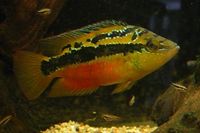Salvini Cichlid (Cichlasoma salvini)
From The Aquarium Wiki
Salvini Cichlid
Cichlasoma salvini
208 Litres (55 US G.)
20.1-22.1cm (7.9-8.7 ")
Freshwater
7.0 - 8.0
22 -32 °C (71.6-89.6°F)
5-20 °d
1:2 M:F
5-8 years
Family
Cichlidae
Contents
Additional names
- Salvini Cichlid, Yellow Belly Cichlid, Tricolour Cichlid
Additional scientific names
- Heros salvini, Cichlasoma tenue, Heros triagramma
Origin
- Central America: Atlantic slope, from southern Mexico to Guatemala and Belize.
Sexing
- Males are more colourful, with more contrast between the black and white patches, and have more pointed dorsal and anal fins than females. Females have a patch in the centre of their dorsal fins, and a dark spot at the bottom of their gill plates.
Tank compatibility
- This is a highly predatory and territorial fish and should therefore only be housed with similar sized or larger robust fish in a large tank. If a fish is small enough to be eaten, it will be. Similar sized Central/South American Cichlids like Jack Dempseys may work, as would large Plecos, provided the tank was large enough.
Diet
- A generally unfussy feeder and should readily accept a variety of foods. Should be fed a high quality Cichlid pellet as well as live/frozen foods such as bloodworm. It should be supplemented with vege foods too.
Feeding regime
- Feed once or twice a day.
Environment specifics
- Requires a spacious well filtered tank. Sand substrate is preferred with plenty of caves and hiding places in rocks and bogwood.
Behaviour
- A territorial, predatory and aggressive Cichlid.
Identification
- An attractive Cichlid. It is oval in shape, the body is yellow with a dark irregular band down the lateral line and slightly more slender one above, edged with blue iridescent scales. The fins are edged with blue and red, the head predominantly yellow-green and red hues along the belly. When viewed from the front there should be two dark bars between the eyes and a further two above before the dorsal fin.
Pictures
Videos
| Breeding pair with fry: |
External links
- Fishbase (Mirrors: Error creating thumbnail: Unable to save thumbnail to destination)
